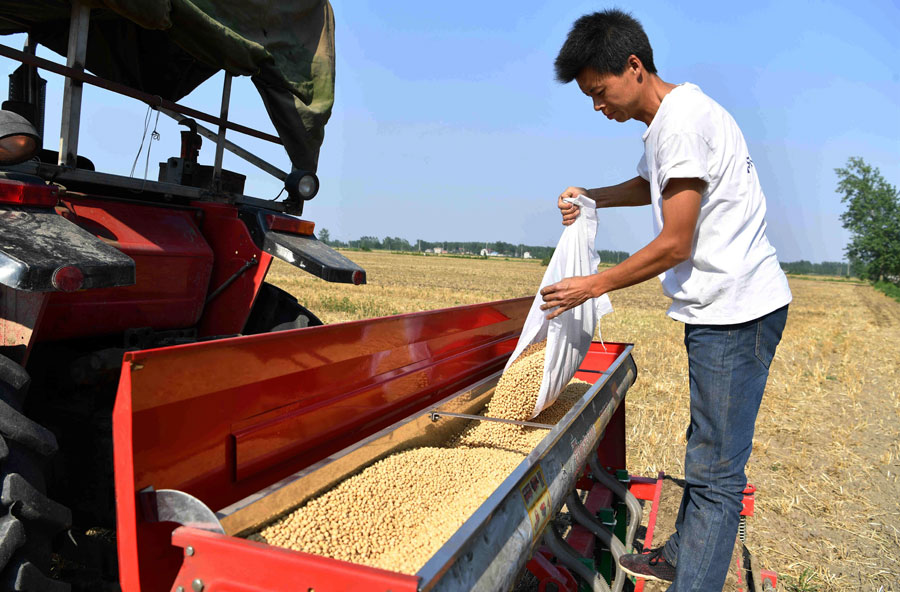
From the People's Daily App.
This is Story in the Story.
More than 20 million rural workers in 25 provincial regions have returned to their jobs as the novel coronavirus (COVID-19) outbreak has abated in China, according to the State Council Leading Group Office of Poverty Alleviation and Development.
Some 2.11 million are from the 52 counties labeled as impoverished, according to Wang Chunyan, deputy director of the office's general department.
"They account for 83 percent of last year's migrant workers in the 52 counties," Wang said.
There are around 370,000 projects in 22 provincial regions in the west, and 220,000, or 60 percent, have resumed construction.
Advanced technology is also helping rural residents and farmers return to work.
According to the provincial agricultural and rural affairs department, 1.4 million agricultural machines will be put into use for this year's spring farming season, including 450,000 fertilizing and sowing drills, and about 4,000 drones.
Today’s Story in the Story looks at how rural residents and farmers are returning to work after the novel coronavirus outbreak.

A worker is busy with her job in a wedding dress factory in Huichang county, Jiangxi province, on March 12. The factory employs workers from poor families. (Photo: China Daily)
Migrant workers can be found in a large percentage of rural families still mired in poverty or those who have recently shaken it off. Two-thirds of their income comes from earnings from working outside.
Central authorities have prioritized the employment of rural workers as well as efforts to make sure they do not get laid off amid the epidemic.
Local authorities have arranged chartered buses and trains for 1.38 million migrant workers returning to work. By the end of March, an estimated 5 million had yet to return to their posts at factories or construction sites.
"We will actively give them guidance and create conditions for them to resume work as soon as possible," Wu Chunyan said.
Aside from travel restrictions that prevented migrant workers from reaching their jobs, COVID-19 also disrupted logistics chains at the height of the outbreak, leading to the lackluster sales of farm produce and threatening to push many back into poverty.
To reduce the impact, several government agencies have launched a campaign to promote the consumption of farm produce from impoverished regions.
Nine eastern provinces have purchased farm produce worth more than 2.1 billion yuan, Wu said, adding the farmer's dilemma has generally been relieved.
To shake off poverty, farmers need to prove they have access to safe housing and clean drinking water, among other requirements.
Holding a remote control, Gong Ming, a farmer in Anhui Province, skillfully operated three drones that were spraying herbicides on 100 hectares of winter wheat.
"Each drone carries 20 kilograms of herbicides and can spray more than half a hectare in 10 minutes," said Gong, adding that it used to take a whole day to spray 1.33 hectares of farmland manually.

A farmer uses a machine to plant soybeans in Bozhou, Anhui province. (Photo: China Daily)
This is the "golden time" for spring plowing and sowing in China. While villagers are confined at home to curb the COVID-19 outbreak, modern technology has come to the fore, helping to mitigate the temporary labor shortage and secure a bumper harvest.
Zhao Jinbao, 56, runs a machinery cooperative in Huoqiu County, which offers mechanized services to local farmers via 50 agricultural drones and 28 rice transplanting machines.
"We have disinfected the village with five drones, and four other drones have helped farmers spray herbicides on 386 hectares of wheat," said the 56-year-old, who plans to rent more land this year.
In Ningyang County, in East China's Shandong province, more than 1 million farmers can purchase materials and select machines online.
Agricultural experts are also going online to show farmers how to take care of their land. About 10 WeChat groups have been set up in Zanhuang County, in the northern province of Hebei, to solve farmers' problems in terms of production, animal husbandry, and orchard management.
At the same time, farmers are working to improve the quality of their produce.
"I will expand my plantation of high-quality rice from 14 hectares to 26.7 hectares this year, as the price of the new rice variety is more than twice that of the old one," said Chen Xiangsheng, head of a cooperative in Shou County, Anhui.
"The upgrade in agriculture will help farmers to gradually eradicate the old methods of relying on the weather for harvests, and further accelerate the process of agricultural modernization in China,” said An Yufa, a professor at China Agriculture University.
(Produced by Nancy Yan Xu, Lance Crayon, Brian Lowe and Da Hang. Music by bensound.com. Text from China Daily.)


